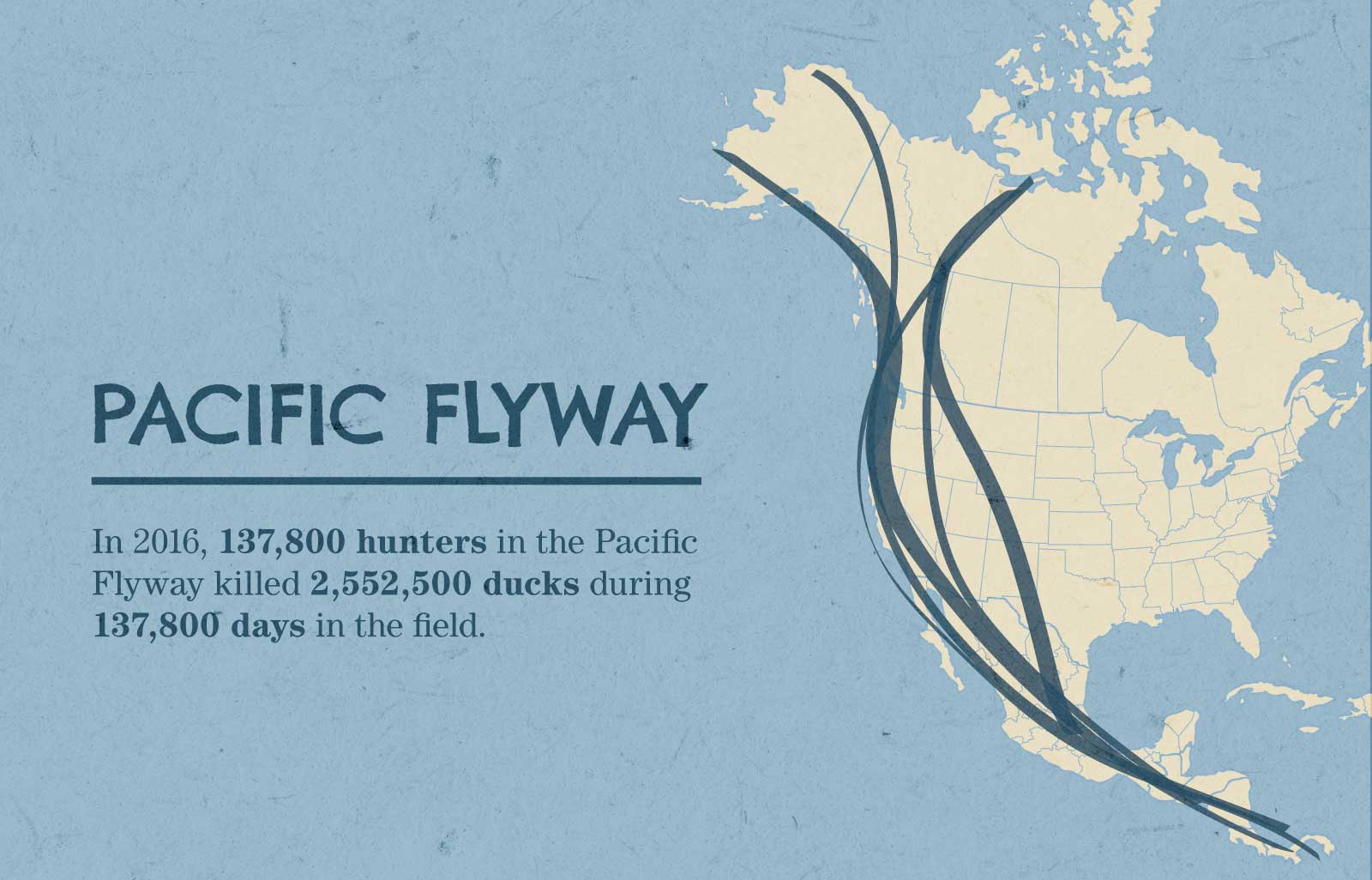Infographic: What You Need to Know About Migrating Ducks and Geese
OutdoorHub Reporters 09.27.17

Millions of waterfowl migrate to southerly regions each fall, and though it’s uncertain how they find their way, biologists believe they use the sun, moon and stars as sky maps, follow major landmarks such as rivers and mountains, and even use the force of natural magnetic fields to navigate incredible distances down the continent’s four distinct flyways.
According to the “2017 Waterfowl Breeding and Population Habitat Survey,” habitat conditions in the northern breeding grounds this spring were similar to or improved relative to 2016, and the total estimated population stood at 47.3 million ducks — down slightly from the 48.4 million estimate in 2016, but still well above the North American Waterfowl Management Plan’s overall population goal.
Check out the infographic below, which was produced in cooperation with our friends at Cabela’s, before you head into the field this fall. It will give you a better understanding of the routes taken by ducks and geese during their annual migration, as well as the specific species found in the four primary flyways. Good luck this waterfowl season!

The Pacific Flyway includes Alaska, Arizona, California, Idaho, Nevada, Oregon, Utah, Washington, and portions of Colorado, Montana, New Mexico, and Wyoming west of the Continental Divide. Canadian provinces of Yukon, British Columbia and western Alberta.

Duck Species Composition
Mallard, Domestic Mallard, Gadwall, Wigeon, Green-winged Teal, Blue-winged Teal, Cinnamon Teal, Northern Shoveler, Northern Pintail, Wood Duck, Redhead, Canvasback, Greater Scaup, Lesser Scaup, Ring-necked Duck, Goldeneyes, Bufflehead, Ruddy Duck, Scoters, Hooded Merganser, other Mergansers, and other ducks.
 Goose Species Composition
Goose Species Composition
Canada Goose, Snow Goose, Ross’ Goose, White-fronted Goose, and other geese.
A total of 85,100 hunters spent 463,500 days afield in the Pacific Flyway last year and killed 414,700 geese.
Waterfowl Fact: About 750,000 northern pintail ducks (about 25% of the U.S. population) stage in the Great Salt Lake wetlands area on their way to their wintering grounds in California’s Central Valley, the Texas Gulf Coast and central Mexico.

The Central Flyway includes Montana, Wyoming, Colorado, New Mexico, Texas, Oklahoma, Kansas, Nebraska, South Dakota, North Dakota, and the Canadian provinces of Alberta, Saskatchewan and the Northwest Territories.

Duck Species Composition
Mallard, Mottled Duck, Gadwall, Wigeon, Green-winged Teal, Blue-winged Teal, Cinnamon Teal, Northern Shoveler, Northern Pintail, Wood Duck, Redhead, Canvasback, Greater Scaup, Lesser Scaup, Ring-necked Duck, Goldeneyes, Bufflehead, Ruddy Duck, Scoters, Hooded Merganser, other Mergansers, and other ducks.
 Goose Species Composition
Goose Species Composition
Canada Goose, Snow Goose, Blue Goose, Ross’ Goose, White-fronted Goose, Brant, and other geese.
During the 2016 waterfowl season, 140,300 Central Flyway goose hunters spent 677,200 days afield and killed 912,200 birds.
Waterfowl Fact: The ban on lead (toxic) shot for waterfowl shooting was phased in starting with the 1987-88 hunting season. It became a nationwide regulation in 1991.

The Mississippi Flyway includes Alabama, Arkansas, Indiana, Illinois, Iowa, Kentucky, Louisiana, Michigan, Minnesota, Mississippi, Missouri, Ohio, Tennessee, Wisconsin and the Canadian provinces of Saskatchewan, Manitoba, and Ontario.
 Duck Species Composition
Duck Species Composition
Mallard, Domestic Mallard, Black Duck, Mallard/Black Duck Hybrid, Mottled Duck, Gadwall, Wigeon, Green-winged Teal, Blue-winged Teal, Cinnamon Tea, Northern Shoveler, Northern Pintail, Wood Duck, Redhead, Canvasback, Greater Scaup, Lesser Scaup, Ring-necked Duck, Goldeneyes, Bufflehead, Ruddy Duck, Long-tailed Duck, Scoters, Hooded Merganser, other Mergansers and other ducks.

Goose Species Composition
Canada Goose, Snow Goose, Blue Goose, Ross’ Goose, White-fronted Goose, Brant, and other geese.
Waterfowl Fact: The greater scaup is also known as bluebill, and it’s estimated that 75% of its North American population breeds in Alaska.
 The Atlantic Flyway includes Connecticut, Delaware, Florida, Georgia, Maine, Maryland, Massachusetts, New Hampshire, New Jersey, New York, North Carolina, Pennsylvania, Rhode Island, South Carolina, Vermont, Virginia, West Virginia & Canadian territory of Nunavut and provinces of Newfoundland, New Brunswick, Nova Scotia, Ontario, Prince Edward Island.
The Atlantic Flyway includes Connecticut, Delaware, Florida, Georgia, Maine, Maryland, Massachusetts, New Hampshire, New Jersey, New York, North Carolina, Pennsylvania, Rhode Island, South Carolina, Vermont, Virginia, West Virginia & Canadian territory of Nunavut and provinces of Newfoundland, New Brunswick, Nova Scotia, Ontario, Prince Edward Island.

Duck Species Composition
Mallard, Domestic Mallard, Black Duck, Mallard/Black Duck Hybrid, Mottled Duck, Gadwall, Wigeon, Green-winged Teal, Blue-winged Teal, Cinnamon Teal, Northern Shoveler, Northern Pintail, Wood Duck, Redhead, Canvasback, Greater Scaup, Lesser Scaup, Ring-necked Duck, Goldeneyes , Bufflehead, Ruddy Duck, Long-tailed Duck, Eiders, Scoters, Hooded Merganser, and other Mergansers.

Goose Species Composition
Canada Goose, Snow Goose, Blue Goose, Ross’ Goose, White-fronted Goose, Brant, and other geese.
Atlantic Flyway goose hunters, numbering 148,800, killed 754,000 geese last year.
Waterfowl Fact: The long-tailed duck is among the most vocal waterfowl species; flocks can be heard from great distances. Many hunters know this duck by its former (and very disrespectful) name of oldsquaw. Ironically, male long-tailed ducks are the chatty ones.
Source: U.S. Fish and Wildlife Service, “Migratory Bird Hunting Activity and Harvest During the 2015-16 and 2016-17 Hunting Seasons”—August 2017 and the “Waterfowl Population Status”-August 2017
Reference Links:

